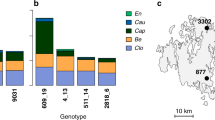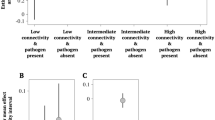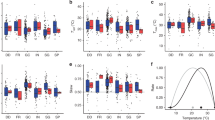Abstract
Pathogens play an important part in shaping the structure and dynamics of natural communities, because species are not affected by them equally1,2. A shared goal of ecology and epidemiology is to predict when a species is most vulnerable to disease. A leading hypothesis asserts that the impact of disease should increase with host abundance, producing a ‘rare-species advantage’3,4,5. However, the impact of a pathogen may be decoupled from host abundance, because most pathogens infect more than one species, leading to pathogen spillover onto closely related species6,7. Here we show that the phylogenetic and ecological structure of the surrounding community can be important predictors of disease pressure. We found that the amount of tissue lost to disease increased with the relative abundance of a species across a grassland plant community, and that this rare-species advantage had an additional phylogenetic component: disease pressure was stronger on species with many close relatives. We used a global model of pathogen sharing as a function of relatedness between hosts, which provided a robust predictor of relative disease pressure at the local scale. In our grassland, the total amount of disease was most accurately explained not by the abundance of the focal host alone, but by the abundance of all species in the community weighted by their phylogenetic distance to the host. Furthermore, the model strongly predicted observed disease pressure for 44 novel host species we introduced experimentally to our study site, providing evidence for a mechanism to explain why phylogenetically rare species are more likely to become invasive when introduced8,9. Our results demonstrate how the phylogenetic and ecological structure of communities can have a key role in disease dynamics, with implications for the maintenance of biodiversity, biotic resistance against introduced weeds, and the success of managed plants in agriculture and forestry.
This is a preview of subscription content, access via your institution
Access options
Subscribe to this journal
Receive 51 print issues and online access
$199.00 per year
only $3.90 per issue
Buy this article
- Purchase on Springer Link
- Instant access to full article PDF
Prices may be subject to local taxes which are calculated during checkout



Similar content being viewed by others
References
Bagchi, R. et al. Pathogens and insect herbivores drive rainforest plant diversity and composition. Nature 506, 85–88 (2014)
Mordecai, E. A. Pathogen impacts on plant communities: unifying theory, concepts, and empirical work. Ecol. Monogr. 81, 429–441 (2011)
Connell, J. in Dynamics of Numbers in Populations (eds den Boer, P. J. & Gradwell, G. R.) 298–312 (PUDOC, 1971)
Gillett, J. B. Pest pressure, an underestimated factor in evolution. Syst. Ass. Publication 4, 37–46 (1962)
Janzen, D. Herbivores and the number of tree species in tropical forests. Am. Nat. 104, 501–528 (1970)
Gilbert, G. S. & Webb, C. O. Phylogenetic signal in plant pathogen–host range. Proc. Natl Acad. Sci. USA 104, 4979–4983 (2007)
Streicker, D. G. et al. Host phylogeny constrains cross-species emergence and establishment of rabies virus in bats. Science 329, 676–679 (2010)
Mack, R. N. in Proceedings of the IX International Symposium on Biological Control of Weeds (eds Moran, V. C. & Hoffman, J. H.) 39–46 (Univ. of Cape Town, 1996)
Strauss, S. Y., Webb, C. O. & Salamin, N. Exotic taxa less related to native species are more invasive. Proc. Natl Acad. Sci. USA 103, 5841–5845 (2006)
Alexander, H. M. Disease in natural plant populations, communities, and ecosystems: insights into ecological and evolutionary processes. Plant Dis. 94, 492–503 (2010)
Mangan, S. A. et al. Negative plant-soil feedback predicts tree-species relative abundance in a tropical forest. Nature 466, 752–755 (2010)
Anderson, R. M. & May, R. M. Population biology of infectious diseases. Part 1. Nature 280, 361–367 (1979)
Burdon, J. J. & Chilvers, G. A. Host density as a factor in plant disease ecology. Annu. Rev. Phytopathol. 20, 143–166 (1982)
Wood, C. L. et al. Does biodiversity protect humans against infectious disease? Ecology 95, 817–832 (2014)
Keesing, F. et al. Impacts of biodiversity on the emergence and transmission of infectious diseases. Nature 468, 647–652 (2010)
Johnson, P. T., Preston, D. L., Hoverman, J. T. & Richgels, K. L. Biodiversity decreases disease through predictable changes in host community competence. Nature 494, 230–233 (2013)
Randolph, S. E. & Dobson, A. D. Pangloss revisited: a critique of the dilution effect and the biodiversity-buffers-disease paradigm. Parasitology 139, 847–863 (2012)
Power, A. G. & Mitchell, C. E. Pathogen spillover in disease epidemics. Am. Nat. 164 (suppl. 5). S79–S89 (2004)
Wapshere, A. J. A strategy for evaluating the safety of organisms for biological weed control. Ann. Appl. Biol. 77, 201–211 (1974)
Yguel, B. et al. Phytophagy on phylogenetically isolated trees: why hosts should escape their relatives. Ecol. Lett. 14, 1117–1124 (2011)
Strange, R. N. & Scott, P. R. Plant disease: a threat to global food security. Annu. Rev. Phytopathol. 43, 83–116 (2005)
Parker, I. M. & Gilbert, G. S. When there is no escape: the effects of natural enemies on native, invasive, and noninvasive plants. Ecology 88, 1210–1224 (2007)
Swenson, N. G., Enquist, B. J., Thompson, J. & Zimmerman, J. K. The influence of spatial and size scale on phylogenetic relatedness in tropical forest communities. Ecology 88, 1770–1780 (2007)
Webb, C. O., Ackerly, D. D., McPeek, M. A. & Donoghue, M. J. Phylogenies and community ecology. Annu. Rev. Ecol. Syst. 33, 475–505 (2002)
Liu, X. B. et al. Experimental evidence for a phylogenetic Janzen-Connell effect in a subtropical forest. Ecol. Lett. 15, 111–118 (2012)
Mitchell, C. E. & Power, A. G. Release of invasive plants from fungal and viral pathogens. Nature 421, 625–627 (2003)
Elton, C. S. The Ecology of Invasions by Animals and Plants (Univ. of Chicago Press, 1958)
Duncan, R. P. & Williams, P. A. Darwin’s naturalization hypothesis challenged. Nature 417, 608–609 (2002)
Goodell, K., Parker, I. M. & Gilbert, G. S. in Incorporating Science, Economics, and Sociology in Developing Sanitary and Phytosanitary Standards in International Trade (ed. Caswell, J.) 87–117 (National Academy Press, 2000)
Wisz, M. S. et al. The role of biotic interactions in shaping distributions and realised assemblages of species: implications for species distribution modelling. Biol. Rev. Camb. Philos. Soc. 88, 15–30 (2013)
Haff, T. M., Brown, M. T. & Tyler, W. B. The Natural History of the UC Santa Cruz Campus 2nd edn (Environmental Studies, UC Santa Cruz, 2008)
Mack, R. N. in Biological Invasions: A Global Perspective (ed. Drake, J. A.) 155–179 (John Wiley & Sons, 1989)
Baldwin, B. G. & Goldman, D. H. The Jepson Manual: Vascular Plants of California 2nd edn (Univ. of California Press, 2012)
Assess. 2.0. Image Analysis Software for Plant Disease Quantification v. 2.0 (APS Press, 2008)
Gilbert, G. S., Magarey, R., Suiter, K. & Webb, C. O. Evolutionary tools for phytosanitary risk analysis: phylogenetic signal as a predictor of host range of plant pests and pathogens. Evol. Appl. 5, 869–878 (2012)
Webb, C. O. & Donoghue, M. J. Phylomatic: tree assembly for applied phylogenetics. Mol. Ecol. Notes 5, 181–183 (2005)
Gilbert, G. S. & Parker, I. M. Rapid evolution in a plant–pathogen interaction and the consequences for introduced host species. Evol. Appl. 3, 144–156 (2010)
Acknowledgements
We thank C. Webb for development of the methods of phylogenetic ecology. We thank J. Velzy for greenhouse support and the many undergraduates and volunteers who helped with fieldwork and disease assessments from scanned leaves. Editorial comments were provided by M. Kilpatrick, B. Lyon, C. Fresquez, D. Gordon, S. Grove, S. Gulamhussein, J. Harrower, C. Ray, K. Ross and M. Shu; K. Tanner revised Fig. 1. This research was funded by National Science Foundation grants DEB-0842059 and DEB-1136626, and by a Cooperative Agreement 14-8130-1472-CA between G.S.G. and US Department of Agriculture APHIS-PPQ-CPHST PERAL funded from Section 10201 of the Farm Bill.
Author information
Authors and Affiliations
Contributions
I.M.P. and G.S.G. conceived and designed the study, managed the project, performed fieldwork and laboratory work, analysed the data, and wrote the paper. G.S.G. built the supertree R2G2_20140601 and the PhyloSusceptibility model. I.M.P. wrote the initial manuscript. M.S. helped design the study and performed laboratory work. M.B., A.P.W. and R.H. performed fieldwork and laboratory work. R.M. and K.S. contributed the database for the PhyloSusceptibility model.
Corresponding author
Ethics declarations
Competing interests
The authors declare no competing financial interests.
Additional information
Data have been deposited in the Dryad Digital Repository (http://dx.doi.org/10.5061/dryad.kf401).
Extended data figures and tables
Extended Data Figure 1 Phylogenetic tree of grassland and experimental species.
Phylogenetic tree of 43 wild species (open circles) in the grassland habitat and 44 experimentally introduced species (filled circles) of plants. Phylogenetic topology and distances (in Myr) were derived from supertree R2G2_20140601 (see Supplementary Methods and Supplementary Data).
Extended Data Figure 2 Phylogenetic signal in host sharing.
a, b, The influence of phylogenetic relationship on the probability of sharing a pest between two hosts was modelled from a database of 1,670 pests on 210 angiosperm host genera in the US Department of Agriculture Global Pest and Pathogen Database (described in ref. 35). Phylogenetic distances are calculated from the updated phylogenetic tree R2G2_20140601 (Supplementary Information). The regression takes the form of logit(S) = β0 + β1 × log10(PD + 1), where S is the probability of susceptibility and PD is the phylogenetic distance (time of independent evolution, in Myr) between the source and target host genera. The probability that a target host is susceptible to a pest from a source host is then S = exp(logit(S))/[1 + exp(logit(S))]. Coefficients were calculated for nine groups of pests/pathogens: bacteria, fungi, oomycetes, insects, mites, molluscs, nematodes, viruses and plants (Extended Data Table 1). a, b, Coefficients were generated for all pests (a), and for the subset of (polyphagous) pests known from more than one host genus (b). The latter is how the analysis was originally done in ref. 35.
Extended Data Figure 3 Heuristic example of the joint influences of focal species abundance and phylogenetic isolation on disease.
a, b, A few examples can be used to illustrate the joint influences of focal host abundance and the presence of close relatives on disease. Most of the most common species, for example, Avena barbata (Ab), Bromus diandrus (Bd), Raphanus raphanistrum (Rr) and Geranium dissectum (Gd), experienced high levels of diseased tissue, regardless of the identity of their neighbours (a, b, yellow circles). In contrast, although both Medicago polymorpha (Mp) and Taraxacum campylodes (Tc) were very rare (a, blue diamonds), T. campylodes experienced three times as much disease as M. polymorpha, perhaps because it had many more close relatives in the local community (b). Similarly, Convolvulus arvensis (Ca) and Sonchus asper (Sa) were found at the same abundance (a, red squares), but S. asper had more close relatives than C. arvensis (b) and experienced over four times as much disease. At intermediate abundance, Eschscholzia californica (Ec) and Nassella pulchra (Np) had very similar cover, but the latter suffered more than six times as much disease as the former (a, green triangles). Again, the species with more disease co-occurred with several close relatives while the relatively disease-free species was phylogenetically isolated (b). Note that axes are on a log scale.
Extended Data Figure 4 Measuring phylogenetic dispersion of grassland communities.
a, b, Phylogenetic dispersion analysis from one representative site. Open circles show the observed phylogenetic distance among the 29 species found in grassland site 2, for each of 18 quantiles (from 0 to 50%). Grey circles show phylogenetic distance quantiles for random draws from the 529 species in the regional metacommunity (the UCSC campus) (a) or the 43 species found in the surrounding grassland community (b). Size of the grey circle is proportional to the number of times that distance was found in 10,000 independent random draws of 29 species. Solid blue lines show the observed phylogenetic distance at the 7% quantile; dotted lines show medians of the random draws. a, b, The observed distance was 74 Myr less than the median of the random draws from the regional metacommunity at the 7% quantile (that is, phylogenetic clustering, consistent with habitat filtering) (a), and the observed distance was 13 Myr greater than expected from random draws of grassland species only (that is, phylogenetic overdispersion, consistent with negative species interactions) (b). Statistical tests based on independent estimates of dispersion for each of the ten sites are shown in Extended Data Fig. 5.
Extended Data Figure 5 Test of phylogenetic dispersion of grassland communities.
a, Plant species in the grassland were consistently phylogenetically clustered compared to the pattern expected if species were drawn randomly from the regional pool (529 species on the 810-hectare UCSC campus). Values less than zero indicate phylogenetic clustering, while values greater than zero indicate species are more distantly related than random (overdispersed) (Extended Data Fig. 4). One-tailed t-tests (df = 9, P values given) showed species were more closely related than expected through the first quartile (25%). This is consistent with habitat filtering. b, In contrast, species were less closely related than expected if drawn randomly from the 43 species found in the grassland community, especially at shorter phylogenetic distances (through the 7% quantile). Box-and-whisker plots indicate median (dark line), 25th and 75th quartiles (box) and minimum and maximum (whiskers), with the ten sites as replicates.
Supplementary information
Supplementary Information
This file contains Supplementary Methods and additional references. (PDF 285 kb)
Supplementary Data
This file contains Supplementary Data. (TXT 132 kb)
Source data
Rights and permissions
About this article
Cite this article
Parker, I., Saunders, M., Bontrager, M. et al. Phylogenetic structure and host abundance drive disease pressure in communities. Nature 520, 542–544 (2015). https://doi.org/10.1038/nature14372
Received:
Accepted:
Issue Date:
DOI: https://doi.org/10.1038/nature14372
This article is cited by
-
Unraveling the prevalence of soil-borne fungal pathogens in the North China Plain: a global analysis approach
European Journal of Plant Pathology (2024)
-
Dilution of specialist pathogens drives productivity benefits from diversity in plant mixtures
Nature Communications (2023)
-
Interactions between soil microbes and native species drive a diversity-invasibility relationship
Biological Invasions (2023)
-
Using root economics traits to predict biotic plant soil-feedbacks
Plant and Soil (2023)
-
Biodiversity mediates ecosystem sensitivity to climate variability
Communications Biology (2022)
Comments
By submitting a comment you agree to abide by our Terms and Community Guidelines. If you find something abusive or that does not comply with our terms or guidelines please flag it as inappropriate.



